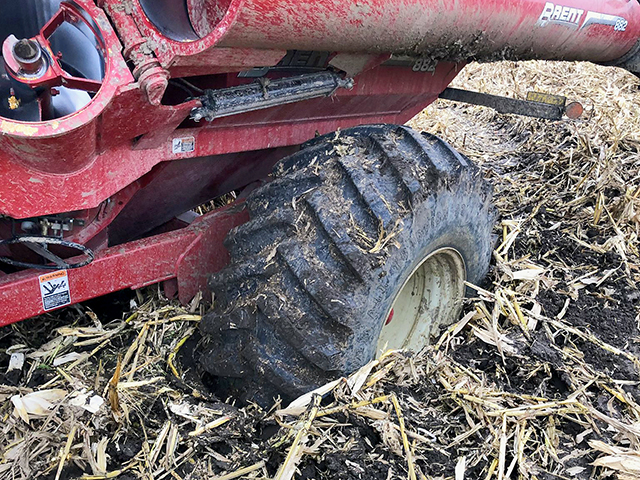Stuck in a Rut
Soil Management - Stuck in a Rut
Deep tillage isn't necessarily the answer to alleviate soil compaction and prevent subsequent yield loss. The once go-to fix may do more harm than good.
Aaron Daigh, a North Dakota State University assistant professor of soil physics, recommends farmers leave chisel plows and disk rippers in the shed. If heavy equipment creates ruts from traversing wet fields during harvest, which occurred frequently last fall and winter, he says the damage is most likely already done.
Farmers can expect crops to yield 20% less on average for the next two years in areas where ruts are visible, Daigh explains. Compaction prevents proper root growth, water infiltration and water availability.
Many farmers believe deep tillage is the way to alleviate compaction, Daigh says. To possibly work, subsoil needs to be dry, and shanks of the primary tillage tool need to get at least 2 inches below the compacted area to lift and break up the ground. A penetrometer is needed to get accurate compaction depth readings.
"Without a measurement, farmers are just aiming in the dark," Daigh asserts. "What we see with deep ripping, it has a low success rate, and you just burn time and diesel. Even if you try to do it, there will still be a level of yield loss."
He advises farmers to fill in ruts once fields are dry so they're smooth for proper seed-to-soil contact while planting. Otherwise, farmers risk poor emergence and stand issues, which also contribute to yield loss. He recommends using secondary tillage implements such as a field cultivator for cuts a few inches deep, hitting them at an angle and not digging underneath.
P[L1] D[0x0] M[300x250] OOP[F] ADUNIT[] T[]
For deep ruts, an excavator may be needed to fill in holes coupled with light tillage. Soil experts urge farmers to wait until fields are fit to do any fieldwork.
"As painful as it sounds, my advice is patience, patience, patience," Daigh adds. "It's very tempting to go out and till to fix problems, and get the ground to dry out faster. But, if it's too wet ... that will only smear or slab over soil, which will prolong and enhance compaction problems."
Joe Morken, of Casselton, North Dakota, followed Daigh's advice this spring. All equipment stayed in the shed until fields dried out, and that included the combine. Persistent rain and early snowstorms last fall ended harvest with about 1,000 acres of corn still standing.
He says combining soybeans last fall left plenty of ruts 3 to 4 inches deep. He didn't want to compound the problem by creating even deeper ones by getting in fields too early this spring.
"We waited to harvest and till until fields were dry so we don't do any more damage," Morken says.
Keep It Loose:
University of Wisconsin Extension guidelines to avoid soil compaction:
> Wait for better soil-moisture conditions before conducting fieldwork, but that's not always possible.
> Reduce axle loads, maintain low equipment tire pressure or use machinery with tracks, if possible.
> Manage equipment traffic patterns to contain and reduce soil damage.
> Don't assume subsoiling is needed.
> Surface tillage might be needed to address ruts.
> Cover crops can help.
> Follow Matthew Wilde on Twitter @progressivwilde.
[PF_1020]
(c) Copyright 2020 DTN, LLC. All rights reserved.




